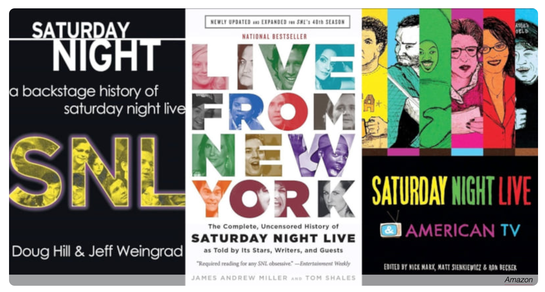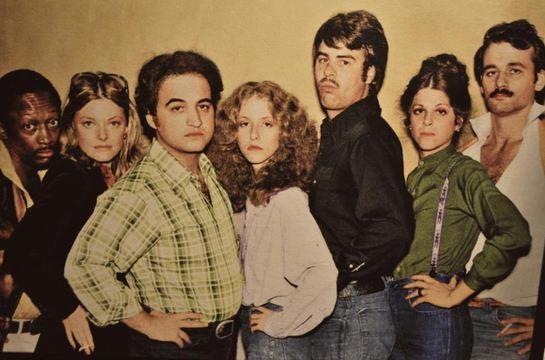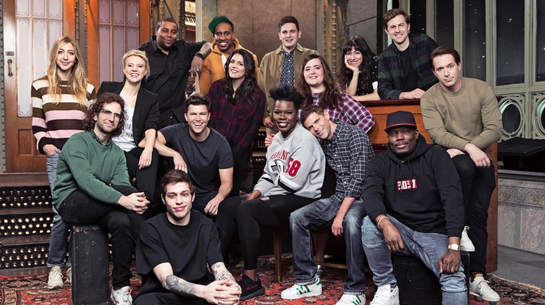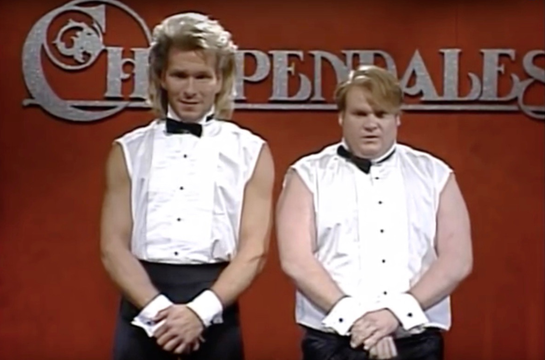How to Build Brand Recall in a Clickless World
Brand awareness is dwindling in organic search. Here's your strategy for building brand equity and recall by leveraging brand awareness. Learn more here.
Read More
For over forty years, Americans could count on three things: death, taxes, and ending their week with a celebrity excitedly shouting “Live from New York, it’s Saturday Night!” from their television screens. Since 1975, the sketch comedy variety show has racked up awards and accolades, faced controversies, fended off multiple cancellation attempts, and managed to somehow remain culturally relevant week after week.
After 45 years on the air, the show has been written about and dissected more than almost any other piece of television. Bookstores are filled with biographies, retrospectives, critical analysis, and coffee table books. Media blogs write thousands of words picking apart every sketch to find the last shred of meaning, homage, and callback. Discussion boards overflow with critique and criticism, charged with each viewers’ personal takes on who the best actors are or what character should be brought back or never shown again. It’s possible, in fact, that every single thing there is to write about, Saturday Night Live has already been written.
Image: women.com
Which is why this post won’t be that. We aren’t going to do a deep dive into the history of SNL, or examine their casting choices or controversies. Instead, this is a look into lessons that brands can learn from one of the longest-running television shows in US history. Thomas Edison famously said, “success is 10% inspiration and 90% perspiration.” With summer rolling in, most people have the perspiration well in hand, so that just leaves that critical 10% of inspiration. Saturday Night Live has that in spades.
Most Saturday Night Live fans don’t realize that the 40th longest-running show in America almost didn’t make it past the first season. In 1976, during the first season, executives at NBC felt that the show’s Nielsen Ratings were too low. Based on a single snapshot, there was serious talk about canceling any future seasons for the program after just a single season.
Fortunately for NBC and for everyone who has grown to love the show, producer Lorne Michaels was a bit savvier than network executives. It turned out that while overall ratings weren’t the highest in their time slot, the show resonated especially well with Baby Boomers. This was a key demographic for advertisers. For decades, they represented the single biggest block of consumer spending power in the country — it wasn’t until 2019 that they were overtaken in population by Millenials, and they still represent the lion’s share of total spending power.
Original SNL cast; Image: Pinterest
There was a generational divide in television consumption habits in the 1970s; Gen Xers spent hours in front of the screen, Baby Boomers didn't. This was a big headache for advertisers at the time — they wanted to target the bigger dollar signs wielded by the Boomers, but often resorted to the smaller market of Gen Xers who watched more TV but were younger and so had less spending power and bought fewer big-ticket items. So when network executives started talking about canceling the program, Michaels brought out his secret weapon. Buried in the Nielsen reports, data showed that the Boomers loved this new live variety show. Besides major league sports, it was the highest-rated show in this difficult-to-reach demographic.
There are two very important lessons brands can take away from this story. The first is simple: know which customers you need to reach. Not every customer is equally important, and it’s critical for brand managers and marketers to be able to quickly and accurately articulate who the most valuable customers are.
Being able to isolate MVP demographics gives marketers a serious advantage when it comes to selling their product. Better targeting often leads to significantly lower CPCs for paid advertising while simultaneously increasing conversion rates, leading to a much better ROAS. It also allows marketers to focus limited resources, both financial and human, towards customers that will have a higher overall customer lifetime value and can reduce general acquisition costs. There is not a single marketing performance metric that doesn’t improve when efforts aren’t focused on a key niche or demographic.
The second lesson is the importance of setting the correct KPIs and knowing how and what to report. Reporting is an art, and reporting is a science. If Michaels had just allowed himself to look at top-line numbers, SNL would probably never have happened, not in the way we know and love it today. Instead, he found the information that was important and set the right KPIs to justify continued investment.
Marketing reporting requires the same ability to know what to report and what it means beyond the top line. Great reporting accomplishes more than just keeping executives in the loop. It tells a story about how well you’re performing, and where performance can be improved. But to get to that story requires an understanding of what is actionable insight and what is just filler or noise.
Take for instance digital marketing’s thankfully waning obsession with bounce rates. No one wants to have a high bounce rate, and rightfully so, but without digging deeper into that stat, it’s impossible to say whether it’s a problem or not really a big deal, regardless of what the actual number is. Websites that sell very specialized products to a very small audience might have a high bounce rate just because their SEO is great but the landing pages do a good job of filtering out poor customers. Websites that are content-heavy or have a lot of scripts and analytics hooks might have a single-digit bounce rate, but don’t generate any revenue because the top-line number is artificially depressed.
Similarly, being able to explain why the top-line numbers aren’t the be-all-end-all is critical for marketers and brand managers when presenting to senior management. Being able to tell the deeper, more meaningful story can be the difference between successfully justifying a campaign and getting a major budget cut.
A 45-year run with no end in sight is a feat. Of the hundreds of tv shows that have aired in the US, less than 50 have made it that far, and even fewer when you discount sports, news, and talk shows. And yet despite being well into middle age, Saturday Night Live constantly feels fresh and able to connect with young audiences and new viewers. Sure, it’s had some seasons that are worse than others, but every new season and new episode always manages to feel very “now.”
Cast of SNL, Season 45; Image: Medium
Cultivating that kind of timelessness doesn’t happen by accident. Instead, it’s the result of some very clear choices that brands would do well to pay attention to. And the two biggest choices are almost contradictory and difficult to balance right: the need for a single clear, cohesive, and timeless vision, and the need to regularly bring in new talent with new perspectives and new approaches.
Vision is simple enough to understand, if difficult to master. Great brands begin with a singular vision that paints a clear picture of what they want to provide to who — and most importantly — how. It’s more than a tagline or a company culture document that no one reads after it’s been written. Lorne Michaels had a very clear idea of the show he wanted to make. He fought for it throughout its 45-year run and even during his hiatuses, that spirit lived on.
Great brands need to have that same clarity that is enforced in every decision, every campaign, every hire, and every product. That starts with clearly articulating what the brand is about. But that’s just the first step, the next is putting in place processes that ensure that vision is carried out.
In Michaels’ case, that meant a set of show guidelines that had to be met and a strict list of expectations for both cast and guest stars. Some huge names were not asked to come on the show, or asked never to come on again because they jeopardized the vision or broke the process — brands need to be just as willing to metaphorically tell Frank Zappa to not bother coming back if it means being true to who they really are. Just like the classic “Cowbell” skit, in which a producer keeps interrupting Blue Oyster Cult recording their hit “(Don’t Fear) The Reaper” to tell them they need more cowbell, brand managers need to constantly interrupt everything to make sure that the vision runs true.
Chris Farley may not have been the right performer for Chippendales, but fresh talent is critical to keeping brands fresh. The second secret to SNL’s constant freshness is the regular cycling of the cast. As tastes change, old cast members go on to bigger things while new, young comedians are brought in to fill out the ranks. This is such a critical component, in fact, that the few times the show tried to bring in established comedians instead of fresh faces resulted in what most fans consider to be the worst seasons in the show’s history.
Chris Farley (right) and Patrick Swayze (left); Image: alfranken.com
The point isn’t that brands need to constantly cycle out marketers. Turnover isn’t good. Instead, the point is that brands need to constantly fill in roles at the bottom with a diverse melange of eager new employees, and then brands need to empower them to be able to make their mark. This means including junior employees in high-level strategy discussions, opening up campaigns and initiatives to opinions and feedback from outside the inner circle, and it means striving for a diverse workplace at every level.
Brands that succeed in opening themselves up to a wide range of thought do better than brands that don’t. It’s that simple. Companies that want to make sure that they don’t get stuck in a rut, that the next product launch is just as successful as the last, can’t afford to sit back on their laurels. They also can’t afford to make their marketing department look like it’s full of clones of the Chief Marketing Officer — after all, some of the most well-liked and successful Saturday Night Live alumni looked nothing like Lorne Michaels.
This is usually the part of the unrolling where we close out our point and leave you with a list of actionable takeaways. But since this about SNL, we’re going to do it a little bit differently this time. SNL is one of the longest-lasting, most successful television shows of all time. It’s weathered shake-ups at NBC, changing casts and crew, and radical shifts in consumer preferences and media composition. And it’s still here. So to help brands internalize the lessons of SNL, put on your Stuart Smally sweater and repeat these affirmations in front of a mirror:
Last updated on December 3rd, 2025.



